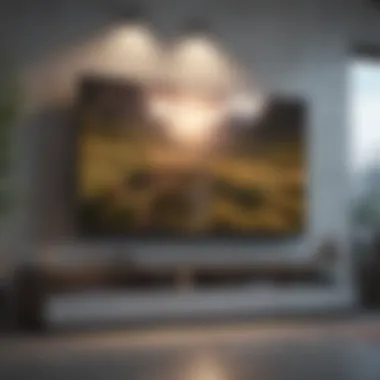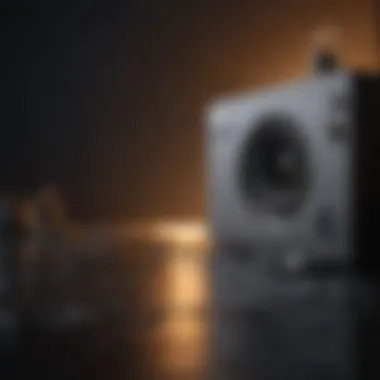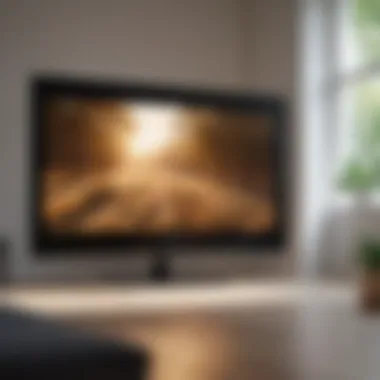Essential Tips for Cleaning Your LED TV Screen


Intro
Keeping an LED TV screen clean is not just about aesthetics; it plays a crucial role in maintaining the life and performance of your beloved device. Over time, dust, fingerprints, and smudges can accumulate, resulting in a viewing experience that lacks clarity. For many, our televisions serve as the portal to countless worlds, from gripping dramas to immersive travels. Thus, understanding how to properly care for an LED screen is paramount to optimizing our enjoyment and reserving its longevity.
In this guide, we will tackle various methods and techniques to safely clean your LED screen, ensuring that you avoid potential pitfalls that can arise from improper cleaning habits. [*] We'll discuss the types of cleaning solutions that can be used without causing damage, appropriate materials, and fundamental best practices that preserve the integrity of your display.
This isn’t just about clearing obstructions from your screen surface; it’s about enhancing the colors, contrasts, and clarity, allowing your screen to provide an immersive visual experience. Let’s delve deeper into the methods and ensure your LED television always shines bright.
Understanding the Importance of Cleaning
Cleaning an LED TV screen is more than just a chore; it’s a vital part of preserving the device. A smudge or a speck of dust can significantly impair the viewing experience, reducing the clarity of the picture and, in some cases, might even harm the screen over time. Regular cleaning acts as a protective measure, ensuring that the display shines its brightest and works optimally.
When you think about the investment you've made in a high-quality television, the importance of keeping it clean becomes clear. Many overlook this simple task, preferring instead to let dust and fingerprints accumulate. However, it's not just about appearances; the effects on picture quality can be stark. By routinely cleaning your screen, you also develop a habit that contributes to the longevity of the device.
Impact of Dust and Smudges on Picture Quality
Dust and smudges on your LED TV screen act like a veil, dulling colors and reducing contrast. Depending on the angle from which you’re viewing, these particles can create glare, making it difficult to appreciate the clarity and vibrancy the screen is designed to provide. For instance, imagine you’re engrossed in a breathtaking nature documentary featuring lush landscapes. With a dirty screen, the rich greens and blues would look washed out, and fine details would be lost.
Furthermore, the buildup of dust might lead to overheating if it settles in or around air vents, causing the internal components to fail prematurely. In essence, your screen's aesthetic and functional performance degrades when maintenance is neglected, thus impacting your viewing pleasure.
Benefits of Regular Maintenance
Keeping your LED TV squeaky clean has multiple advantages that go beyond mere aesthetics. Regular maintenance helps:
- Enhance Picture Quality: A clean screen ensures that colors pop, contrasts are sharp, and the details remain crisp and vivid, giving you the immersive experience you expect from modern displays.
- Extend Lifespan: Just as you wouldn’t leave your car or your house to gather dust, your television deserves that same level of care. Regular cleaning can help prevent damage and keep your device running longer.
- Improve Viewing Comfort: A clean screen reduces reflections and glare, allowing you to enjoy your favorite shows comfortably without straining your eyes.
As you can see, prioritizing the cleanliness of your LED screen serves both practical and aesthetic purposes, enhancing your viewing experience and protecting your investment.
"It's the little things that make a big difference; keeping your TV clean is one of those things that can transform your space and experience."
Ultimately, understanding the importance of cleaning your LED TV screen lays the groundwork for better maintenance practices that will keep your device in peak condition.
Identifying the Materials Needed
Before diving into the delicate art of cleaning your LED TV screen, it’s absolutely crucial to know what materials will help you get the job done right. Choosing the right items not only ensures a pristine viewing experience but also prevents unintentional damage. The materials you select can have a significant impact on cleaning efficiency and the longevity of your screen. Getting it right means you aren't left with streaks, scratches, or worse—permanent harm to your investment.
Microfiber Cloths
First on the list is the microfiber cloth. This fabric has become a staple for cleaning delicate surfaces, and for good reason. Microfiber is designed to lift and trap dust, dirt, and oils without scratching your screen.
Using an ordinary rag may risk leaving behind fibers or causing minute scratches. Not only does a microfiber cloth clean effectively, but it’s also gentle enough for LCD and LED displays. For optimal results, choose one that is soft and has a tight weave. Additionally, keep a few on hand—having a fresh cloth for each cleaning session goes a long way in maintaining clarity.
Cleaning Solutions: Safe or Not?
Commercial Screen Cleaners
When it comes to cleaning solutions, commercial screen cleaners can be a go-to option for many people. These products are developed specifically for electronics, and they often come in convenient spray bottles, making application easy and consistent. A key characteristic that makes them favorable is their balanced pH, which means they generally will not harm your screen's coating. However, not all commercial cleaners are created equal; some may have additives that could do more harm than good.


Look for reputable brands that boast non-toxic and ammonia-free formulations. Some cleaners even come with microfiber cloths included, making them a convenient choice.
DIY Cleaning Solutions
On the other hand, DIY cleaning solutions often pique the interest of those who prefer a home-grown approach. A popular mixture involves combining distilled water with a touch of white vinegar. The simplicity of this method appeals to many, as it's typically cheap and readily available.
A unique feature of DIY solutions is that you know precisely what you're using. You can avoid the hidden chemicals that often lurk in commercial products. However, users should exercise caution: too much vinegar can leave an unpleasant smell, and excessive use might not be ideal for some screen coatings.
Avoiding Harmful Products
Alcohol-Based Cleaners
Many people might think that a good alcohol-based cleaner would do wonders for an LED screen. However, that assumption can lead to regret. Alcohol is effective in disinfecting, but it can also break down the protective layers on your screen, causing irreversible damage. The key takeaway? While it cleans well, alcohol's potential for harm outweighs its benefits in this context. That’s a tight rope to walk, and it’s simply not worth the risk—better safe than sorry.
Paper Towels
It's tempting to grab a paper towel and start wiping away, but that could be a grave mistake. Paper towels tend to be abrasive, and many are laced with texture that can scratch your delicate screen. Beyond that, they can leave streaks that defeat your cleaning efforts entirely. While they may be convenient for general household cleaning, think twice before using them on your TV screen. Stick with specialized cloths to avoid unnecessary headaches.
Proper material selection not only enhances cleaning efficacy but also safeguards your valuable technology for years to come.
In summation, the right cleaning materials can make a world of difference when it comes to maintaining your LED screen. A good microfiber cloth combined with a safe cleaning solution can enhance your viewing experience while preserving the life of your investment.
Best Practices for Cleaning an LED TV Screen
In the realm of electronics, the fine line between aesthetics and technology is often blurred, especially when it comes to something as visually prominent as an LED TV screen. Keeping that screen clean can greatly enhance your viewing experience. Dust, fingerprints, and smudges can detract from picture quality, turning what should be a cinematic moment into a frustrating one. Implementing best practices for cleaning is not only about maintaining clarity but also about extending the life expectancy of the device. Handling cleaning duties with care ensures that expensive equipment remains in top-notch condition.
Turning Off the Television
Why It Matters
One might wonder why powering down the device is a must before diving into a cleaning spree. Turning off the TV, in all its simplicity, is remarkably significant. First off, it prevents any accidental damage while cleaning. It’s easier to see smudges and dust when the screen isn’t lit. Moreover, it avoids the risk of electric shock. If the screen is wet during the cleaning process, damages to the internal workings of the TV can occur if it’s left on. This approach is undoubtedly beneficial because it ensures both user safety and cleaner results.
Dusting Before Wiping
Using a Microfiber Cloth Effectively
When it comes to initial clean-up, using the right material makes a world of difference. Microfiber cloths are a favorite for good reason. They’re gentle on surfaces, reducing the chance of scratches, and they trap dust particles effectively. Unlike regular cloths, these specialized fabrics do not leave lint, making them ideal for screens. Using a microfiber cloth properly means gentle, sweeping motions rather than harsh rubbing. It’s no small feat, yet it ensures that the cleaning process remains gentle while still being effective.
Applying Cleaner Carefully
Spraying Technique
When introducing cleaning solutions, the technique of applying them is paramount. The spraying method should be straightforward. Instead of spraying directly onto the screen, it’s advisable to lightly mist the cleaner onto the microfiber cloth. This way, you minimize the chances of liquid pooling in any crevices or areas that might risk damaging the internal components. It’s a cleaner method that enhances safety during the cleaning process, and steering away from direct contact helps maintain the integrity of your device.
Avoiding Over-Saturation
While the right cleaner can work wonders, too much of a good thing is often counterproductive. Over-saturation can lead to grime build-up, ultimately detracting from the clarity intended. If cleaners are oversaturated on a cloth or screen, they can seep into areas where they ought not to venture, causing potential damage. Finding the right balance ensures that all spots are addressed without yielding excessive moisture, thus preserving the display in a better condition for longer.
Wiping with Precision


Direction of Wiping
The direction in which one wipes the screen is more crucial than it might seem at first glance. Adopting a circular wiping pattern could lead to streaks, while horizontal and vertical motions help in even distribution. This method aids in ensuring that dirt is effectively lifted rather than smudged around. By adhering to a consistent direction, one can achieve a clearer end result. Taking the time to focus on this detail ultimately leads to a sparkling surface that enhances the overall viewing pleasure.
"A clean screen results in not just better images but a prolonged life for your device."
Following these best practices will not just leave the TV screen looking pristine; it serves a greater purpose, like improving the overall performance and longevity of your investment.
Common Mistakes to Avoid
Cleaning an LED TV screen requires a delicate touch. Familiarizing yourself with common pitfalls can prevent potential damage and extend the life of your device. In this section, we’ll take a closer look at three significant mistakes—using incorrect materials, applying too much pressure, and skipping maintenance. Understanding these issues can save both your screen’s clarity and your investment in the technology.
Using Incorrect Materials
Selecting the right cleaning materials is crucial. Many people make the error of reaching for household products like Windex or other alcohol-based cleaners. These might work wonders on your kitchen counter but can wreak havoc on your TV screen.
- Why Avoid Incorrect Materials?
Using non-approved cleaners may strip away coatings that protect your display. Additionally, rough materials such as paper towels can scratch the delicate surface. Stick solely to microfiber cloths; they’re soft and won’t leave lint behind. - Why It Matters:
Make the right choice, and there’s a higher chance the display remains scratch-free and vibrant. Your screen displays thrilling images, so it’s only fair to treat it with respect.
Applying Too Much Pressure
It’s easy to think that a bit of muscle will give you a spotless screen, but that’s a mistake. Many folks press down hard, hoping to remove stubborn smudges. However, excessive pressure can lead to serious issues.
- Consequences of Over-Pressuring:
Over time, applying too much force can lead to damaged pixels or a worn-out screen. Imagine spending a pretty penny on a big-screen TV, only to compromise its integrity due to a moment of overzealous cleaning. Gentle, even strokes are key. Always remember: less is more when it comes to cleaning those delicate displays.
Skipping Maintenance
Once you’ve finally achieved that pristine screen, it’s tempting to think that you’re done for the year. However, regularly maintaining that visual wonder is essential to preserving its quality.
- Why Regular Maintenance Matters:
Dust and grime can build up over time, diminishing picture quality. Ignoring this can not only affect how you see your favorite film but could also lead to more rigorous cleaning routines in the future. Schedule regular wipe-downs to keep the screen fresh.
"An ounce of prevention is worth a pound of cure."
Keeping a consistent cleaning schedule ensures that your viewing experience remains top-notch while avoiding the hassle of extensive clean-ups.
Additional Tips for Prolonged Screen Life
Keeping your LED TV screen in pristine condition goes beyond just a simple wipe-down. Implementing some additional tips can effectively enhance your viewing experience and extend the lifespan of your device. These recommendations cover various aspects, from your environment to your cleaning routine. The goal is to create a condition that not only safeguards the screen but also improves its functionality.
Optimal Viewing Conditions
Creating the right environment for your TV can significantly affect screen quality. Dim lighting proves advantageous as it minimizes glare. Excessive brightness in the room prompts reflections on the screen. Adjusting curtains or shades can help control this kind of light interference. Furthermore, positioning the screen at eye level allows for optimal viewing angles, which lessens the need for brightness and contrast, enhancing your viewing experience.
Regular Cleaning Schedule
Adopting a routine for cleaning your screen is essential. Ignoring it can lead to a build-up of dust and grime, resulting in degraded image quality. Setting a schedule—perhaps once every couple of weeks—ensures that your TV stays clean without introducing further wear. Even if you aren't seeing visible dirt, you can often missed the fine layer of dust that accumulates over time
A regular cleaning approach also helps instill a habit that keeps your TV functioning optimally in the long haul.
Environmental Factors to Consider


Humidity Levels
Humidity plays a larger role than many realize. Typical living areas can have humidity levels that vary significantly; high humidity can lead to moisture accumulation inside electronic devices. When the humidity is too high, water droplets may settle on the screen and within the TV. Over time, this could damage fragile internal components.
An ideal humidity range is between 30% to 50%. This range helps maintain functionality without causing any moisture-related issues. Installing a dehumidifier can also be a proactive solution for susceptible areas.
Proximity to Direct Sunlight
Direct sunlight is another environmental factor that should not be underestimated. Continuous exposure to sunlight not only increases the temperature of the TV but may also result in color fading on the screen. Over time, this could lead to long-lasting damage to the display, resulting in a loss of clarity.
Positioning your LED TV away from windows or using protective curtains can mitigate these effects. Furthermore, consider utilizing shades that can reduce brightness during the day, allowing you to watch comfortably while preserving the screen's quality.
Final Note: Taking these additional steps ensures that your LED screen remains at its best for years to come, minimizing the risk of damage and maintaining captivating picture quality.
Understanding Display Technology
Understanding the underlying principles of display technology is not just for tech experts; it is essential for anyone who wants to keep their LED television screen in pristine condition. Knowing how LED screens work empowers users to avoid common pitfalls during cleaning and maintenance. By recognizing the unique elements of LED technology, one can significantly enhance the viewing experience and prolong the lifespan of the device.
Differences Between LED and Other Screen Types
When it comes to screens, not all are created equal. LED, or Light Emitting Diode technology, is distinct from other types like LCD (Liquid Crystal Display) or OLED (Organic Light Emitting Diode). Here are some key differences to grasp:
- Backlighting: LED screens utilize small diodes as a light source behind the screen, which allows for thinner designs and better energy efficiency. In contrast, LCD screens need a separate backlight on top of their liquid crystal technology.
- Picture Quality: LED screens typically offer brighter visuals and better contrast ratios than older LCD technology, making colors pop and images appear sharper. Meanwhile, OLED screens are renowned for their deep blacks and stunning colors, but they can also come with concerns about burn-in.
- Durability: LED screens are generally more resilient than some alternatives, mainly due to their solid-state technology. However, they are still vulnerable to scratches and marks if not cared for properly.
These distinctions are more than just technical jargon; they influence how one should approach cleaning. For instance, the layer of glass over different types of screens varies in sensitivity, which is vital to know when picking your cleaning materials.
Vulnerability of Screen Coatings
It’s not just the screen itself that needs protection; the delicate coatings used in LED TVs are susceptible to damage if not cleaned properly. The coatings are designed to enhance image quality by reducing glare and reflections. Here are some pertinent considerations regarding those vulnerabilities:
- Anti-reflective Coatings: These coatings significantly improve the viewing experience by minimizing reflections from sunlight or ambient light in a room. However, they can be easily damaged by abrasive cleaning materials or harsh chemicals, leading to permanent streaks and reduced quality.
- Fingerprint Resistance: Many modern LED screens come with fingerprint-resistant coatings. While they can minimize smudges, consistent rough handling can wear down this coating over time. Thus, gentler cleaning methods are not merely recommended—they are necessary to preserve this feature.
- Chemical Reactions: If one uses inappropriate cleaning solutions, they can interact negatively with screen coatings. Products containing alcohol, ammonia, or other harsh chemicals can strip these coatings away, compromising both durability and visual quality.
"Understanding the vulnerabilities of your TV screen coatings can save you from costly repairs down the line."
Taking time to comprehend these technology aspects changes the game when it comes to upkeep. It's a step toward ensuring that one's investment in their viewing experience isn't wasted due to a lack of simple but essential knowledge. Proper care maximizes not just the product's functional longevity but also the enjoyment of countless hours spent engrossed in your favorite shows and movies.
Final Thoughts on LED TV Screen Maintenance
Maintaining your LED TV screen is essential to ensure its longevity and optimal performance. A clean screen not only enhances your viewing experience but also helps in preserving the integrity of the display technology itself. Over time, dust and fingerprints can accumulate, negatively impacting picture quality. Through this guide, we have explored various techniques that will assist in keeping your screen spotless and well-maintained.
Recap of Key Techniques
To wrap things up, here’s a concise recap of the pivotal techniques highlighted throughout this guide:
- Utilize Microfiber Cloths: Always prioritize microfiber cloths for their gentle yet effective dust and smudge removal capabilities. They won’t scratch your screen and are great for day-to-day cleaning.
- Safe Cleaning Solutions: Whether you opt for commercial screen cleaners or whip up a DIY solution with distilled water and vinegar, ensure it’s safe for LED screens.
- Dust Before Wiping: Remember to dust off the screen gently before applying any cleaner. This prevents scratches caused by abrasive particles.
- Turning Off the TV: Always start with a powered-down screen. Not only is it safer, but it helps you see smudges more clearly.
- Careful Application of Cleaner: A light mist on the cloth is essential. You don’t want to over-saturate, which can lead to damage.
- Direction Matters: When wiping, use gentle vertical or horizontal strokes. This helps avoid streaking and ensures comprehensive coverage.
By incorporating these techniques into your cleaning routine, you're bound to see positive results and enjoy a clearer view.
Encouragement for Careful Management
Engaging in thoughtful maintenance of your LED TV screen is not just about aesthetic appearance; it is part of safeguarding your investment. Ideally, aspire to create a schedule for regular cleaning—setting aside some time once a month can go a long way in extending the life of your screen.
Being diligent about conditions that could harm your display, such as avoiding direct sunlight or excessive humidity, combined with careful cleaning practices, can make all the difference.
"An ounce of prevention is worth a pound of cure." This old proverb rings particularly true in the context of electronics maintenance. Take care of your LED TV, and it will serve you faithfully for years to come.







